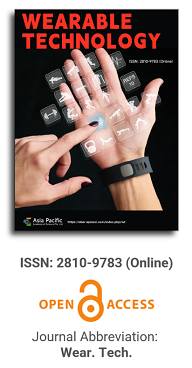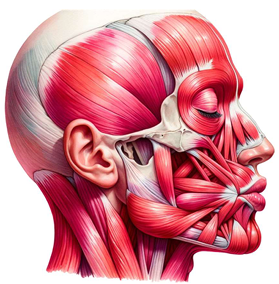

This paper delves deeply into the innovative realm of integrating human emotions with wearable technology. The primary focus is on the conceptualization and development of a kiss transfer device that harnesses the power of wearable technology to bridge the physical gap in human-human interactions. By investigating the intricate nuances of the human-human kissing process, the research seeks to replicate this intimate gesture through a technological medium. The paper not only elaborates on the anatomy, evolution, and hormonal dynamics of kissing but also underscores the transformative potential of wearable technology in capturing and transmitting these intimate moments. This exploration opens up new horizons for long-distance relationships, offering a tangible touchpoint that goes beyond traditional communication methods. Through this pioneering work, the research positions wearable technology as not just a tool for communication but as an extension of our human emotions and expressions.

Mobility aids for visually impaired persons: Journals reviewed
Vol 2, Issue 1, 2021
Download PDF
Abstract
This paper reviews the literature on mobile assistive devices for visual impaired people, in order to have a clear understanding of the technology and technological progress of helping visual impaired people. In this way, it aims to obtain basic guidelines for analyzing the most relevant equipment to help people with impaired vision and highlight the improvements that can be achieved. The most common device is to integrate different sensors and electronic components into the walking stick to improve their obstacle detection ability. In addition, equipment with cameras, including computer vision algorithms and artificial intelligence technology, has been developed to improve the performance and efficiency of the equipment. Finally, the basic characteristics of the auxiliary system are introduced, and it is found that there is no equipment to meet the needs of users.
Keywords
References
- World Health Organization [Internet]. World Health Organization; 2017 [cited 2017 Sep 13]. Available from: http://www.who.int/features/factfiles/blindness/blind ness_facts/en/.
- YZ Cañón. La baja visión en Colombia y en el mundo [Low vision in Colombia and the world]. Cien Tecnol Salud Vis Ocul 2011; 9(1): 117–123.
- Linburg H, Espinoza R, Lansingh VG, et al. Functional low vision in adults from Latin America: Findings from population—Based surveys in 15 countries. Panam Salud Publica 2015; 37(6): 371–378.
- EO´Brien, A Mohtar L, Diment Y, et al. A detachable electronic device for use with a long white cane to assist with mobility. Taylor Francis On Line 2014; 219–226.
- Quintana MQ. Áreas específicas para la atención de personas con discapacidad visual [Specific areas for the care of visually impaired persons]. Secretaria de Educación y Cultura, Chihuahua 2011.
- Pascuas YS, Vargas EO, Sáenz M. Tecnologías de la información y las comunicaciones para personas con necesidades educativas especiales [Information and communications technology for people with special educational needs]. Entramado 2015; 11(2): 240–246.
- Ortiz JA. Accesibilidad tecnológica para limitados visuales en las bibliotecas públicas mayores en la ciudad de Bogotá [Technological accessibility for the visually impaired in major public libraries in the city of Bogota] [Bachelor’s thesis]. Bogotá D.C: Universidad de la Salle, 2009.
- Escobar H, Vélez C, Barrera C. Ayudas externas para mejorar la independencia en personas con discapacidad visual [External aids to improve independence in people with visual impairment]. Revista Cubana de Oftalmología 2015; 1–17.
- Semenoy A. Las tecnologías de la información y la comunicación en la enseñanza [Information and communication technologies in education]. UNESCO Moscú; 2005.
- Documento de posición official—Baja Visión. European Council of Optometry and Optics-ECOO; 2011; Madrid.
- Organización Mundial de la Salud (OMS). Definitions of blindness and visual impairment. 2012.
- Ministerio de Educación Nacional. Orientaciones pedagógicas para la atención educativa a estudiantes con discapacidad motora. 2006.
- Instituto de Salud Carlos III. Investigación en Tecnologías de Inteligencia Ambiental para la Salud del Futuro. 2009.
- García V. Auxiliares de movilidad en la discapacidad visual. Terapia asistida por perros [Mobility aids in visual impairment. Dog-assisted therapy] [Master’s thesis]. Castilla y León: Universidad de Valladolid; 2016.
- Hernández O. Tecnología Asistida: Propuesta de terapia ocupacional para aumentar el desempeño ocupacional de un usuario con parálisis cerebral [Assistive Technology: Occupational therapy proposal to increase the occupational performance of a user with cerebral palsy]. Revista Chilena de Terapia Ocupacional 2013; 13(2): 33–43.
- Egaña A, Ceres F, et al. Detección ultrasónica de obstáculos por medida diferencial para la movilidad de invidentes [Ultrasonic obstacle detection by differential measurement for the mobility of blind persons]. 2004.
- Ávila R. Diseño y construcción de un bastón con sistema ultrasónico producido por un microcontrolador PIC16F84 para niños invidentes y débiles visuales [Design and construction of a cane with ultrasonic system produced by a PIC16F84 microcontroller for blind and visually impaired children] [Master’s thesis]. México D.F: Instituto Politécnico Nacional; 2015.
- Alvarado JD, Mosquera V. Visión Electrónica 2016; 10(1): 1–6.
- Rubio JL, Solon C, Bayan R, et al (editors). Robótica y UX para la Mejora de las Interacciones en el Espacio Urbano: Desarrollo y Perfeccionamiento de un Bastón Electrónico para Invidentes. De IX Congreso Internacional Ciudades Creativas; 2014; Madrid.
- Nieto L, Padilla C, Barrios M. Design and implementation of electronic AID to blind’s cane. 2014 Oct 22–24; Cartagena: IEEE; 2014; p. 932–935
- Wahab A, Helmy M, Talib A, et al. Smart cane: assistive cane for visually—Impaired people. Comput 2011; 8(4).
- Bharambe S, Thakker R, Patil H, et al. Substitute eyes for blind with navigator using android. Proceedings of the India Educators Conference, 38–43.
- Roentgen U, Gelderblom G, Soede M, et al. Inventory of electronic mobility aids for persons with visual impaimente a literature review. Journal of Visual Impairment & Blindness 2008; 102(11).
- Sobrado EA. Sistema de visión artificial para el reconocimiento y manipulación de objetos, usando un brazo robot [Master’s thesis]. Lima: Pontificia Universidad Católica del Perú; 2003.
- González A, Martínez F, Pernia A, et al. Vergara, Técnicas y Algoritmos Básicos de Visión Artificial. La Rioja: Universidad de la Rioja; 2006.
- Liu J, Sun X. A Survey of Vision Aids for the Blind. 6th World Congress on Intelligent Control and Automation; 2006 Jun 21–23; p. 4312–4316.
- Manduchi R, Coughlan J. Computer vision without sight. Communications of the ACM 2012; 55(1): 96–104.
- Carrato S, Marsi S, Medvet F, et al. Computer vision for the blind: A dataset for experiments on face detection and recognition. MIPRO 2016; 1206–1211.
- Vera P, Zenteno D, Salas J. A Smartphone—Based Virtual White Cane. De Pattern Analysis and Applications 2013.
- Lanigan P, Paulos A, Williams A, et al. Trinetra: assistive technologies for grocery shopping for the blind. IEEE Trinetra: Assistive Technologies for Grocery Shopping Wearable Computers 2006; 147–148.
- Krishn S, Panchanathan S. Assistive technologies as effective mediators in interpersonal social interactions for persons with visual disability. Computers Helping People with Special Needs 2010; 316–323.
- LookTel [Internet]. [cited 2017 Oct 17]. Available from: http://www.looktel.com.
- KNFB Reader [Internet]. 2012 [cited 2017 Oct 22]. Available from: http://www.knfbreader.com.
- Ciaffoni Ariadne [Internet]. GPS Mobility and map exploration for all [cited 2017 Oct 22]. Available from: http://www.ariadnegps.eu.
- Tapu R, Mocanu B, Zaharia T. A computer vision system that ensure the autonomous navigation of blind people. IEEE 2013.
- Pena L, Rodríguez Y. Dispositivo apuntador mediante visión artificial, adecuado para usuarios de computador con discapacidad motora en miembros superiors [Machine vision pointing device, suitable for computer users with motor impairment in upper limbs] [Master’s thesis]. Bogotá: Universidad Distrital Francisco José de Caldas; 2015.
- Choque G. Inteligencia Artificial, Perspectivas y realizaciones. Redes Neuronales. La Paz, 2002.
- Salao JR. Estudio de las Técnicas de Inteligencia Artificial mediante el apoyo de un software educativo [Study of Artificial Intelligence Techniques with the support of educational software] [Master’s thesis]. Riobamba: Escuela Superior Politécnica de Chimborazo; 2009.
- Turing AM. Computing machinery and intelligence. Mind Parsing the Turing Test 1950; 49: 433–460.
- Sarraute C. Aplicación de las Redes Neuronales al Reconocimiento de Sistemas Operativos [Application of Neural Networks to Operating System Recognition] [Bachelor’s thesis]. Buenos Aires: Universidad de Buenos Aires; 2007.
- Cantero A, Martínez E. Visión por computadora: identificación, clasificación y seguimiento de objetos. [Computer vision: identification, classification and tracking of objects] [Master’s thesis]. Ciudad del Este: Universidad Nacional del Este; 2014.
- García PP. Reconocimiento de imágenes utilizando Redes Neuronales Artificiales. [Image Recognition using Artificial Neural Networks] [Master’s thesis]. Madrid: Universidad complutense de Madrid; 2013.
- Rocha C, Escorcia J. Sistema de Visión Artificial para la Detección y el Reconocimiento de Señales de Tráfico basado en Redes Neuronales [Machine Vision System for Traffic Signal Detection and Recognition Based on Neural Networks]. De Eighth LACCEI Latin American and Caribbean Conference for Engineering and Technology; 2013 Aug 14–16; Arequipa; 2010.
- Yang X, Tian Y. Robust door detection in unfamiliar environments by combining edge and corner features. IEEE Computer Society Conference on Computer Vision and Pattern Recognition; 2010 Jun 13–18; San Francisco: IEEE; 2010. p. 57–64.
- Mesa H, Branch J, López C. Sistema de detección de esquinas en imágenes digitales en tonos de gris, basado en redes neuronales artificiales [Corner detection system in digital images in shades of gray, based on artificial neural networks]. Avances en Sistemas e Informática 2008; 5(3): 195–200.
- Moreno M, Shahrabadi S, José J, et al. Real time local navigation for the blind: Detection of lateral doors and sound interface. Procedia Computer Science 2012; 14: 74–82.
- Chen X, Yang X, Wang M, et al. Convolution neural network for automatic facial expression recognition. IEEE 2017; 814–818.
- Restrepo GJ. Aplicación del aprendizaje profundo (Deep Learning) al procesamiento de señales digitales [Application of deep learning to digital signal processing] [Master’s thesis]. Santiago de Cali: Universidad Autónoma de Occidente; 2015.
- Ortiz AA. Algoritmo multiclasificador con aprendizaje incremental que manipula cambios de conceptos [Multiclassifier algorithm with in-cremental learning that manipulates concept changes] [PhD thesis]. Granada: Universidad de Granada; 2014.
- Deng L, Yu D. Deep Learning: Methods and Applications. Foundations and Trends® in Signal Processing 2014; 7(34): 197–387.
- Colombo R. Deep Learning para el reconocimiento de imágenes en Raspberry Pi 2 [Deep Learning for image recognition on Raspberry Pi 2] [Master’s thesis]. La Laguna: Universidad de La Laguna; 2016.
- Ibáñez R, Soria A, Teyseyre A, et al (editors). Evaluación de técnicas de Machine Learning para el reconocimiento de gestos corporales [Evaluation of machine learning techniques for the recognition of body gestures.] De 15th Argentine Symposium on Articial Intelligence; 2014; Panamá: ASAI.
- Morales P, Pérez A, Camps-Valls G. Remote sensing image classification with large-scale gaussian processes. IEEE Transactions on Geoscience and Remote Sensing 2017; 56(2): 1103–1114.
- Yu H, Hong R, Huang X, et al. Obstacle detection with deep convolutional neural network. 6th International Symposium on Computational Intelligence and Design; 2013 Oct 18–29; Hangzhou.
- T. Ubbens y D. Shuurman. Vision based obstacle detection using a support vector machine. IEEE 2009; 459–461.
- Poggi M, Mattoccia S. A wearable mobility aid for the visually impaired based on embedded 3rd vision and deep learning. IEEE Workshop on ICT solutions for eHealth 2016.
Supporting Agencies
Copyright (c) 2021 Ahmed Alejandro Cardona Mesa, Ruben Dario Vasquez Salazar

This work is licensed under a Creative Commons Attribution 4.0 International License.

Prof. Zhen Cao
College of Information Science & Electronic Engineering, Zhejiang University
China, China
Processing Speed
-
-
-
- <5 days from submission to initial review decision;
- 62% acceptance rate
-
-
Asia Pacific Academy of Science Pte. Ltd. (APACSCI) specializes in international journal publishing. APACSCI adopts the open access publishing model and provides an important communication bridge for academic groups whose interest fields include engineering, technology, medicine, computer, mathematics, agriculture and forestry, and environment.





